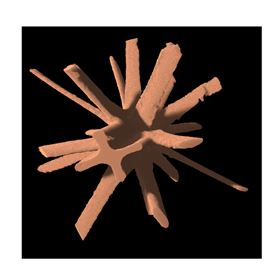Star-shaped plankton inspire complex structures


A common marine planktonic organism, Acantharia, has a delicate star-shaped endoskeleton consisting of 20 arms or ‘spicules’ arranged in a unique geometric pattern. Unusually, these mineralized spicules are built from strontium sulfate. Now researchers from Florida Atlantic University and Helmholtz-Zentrum Hereon in Germany have taken a closer look at Acantharia skeletons to understand how this sub-millimeter-sized planktonic organism forms its spikes [Raja Somu et al., Acta Biomaterialia 159 (2023) 74-82, https://doi.org/10.1016/j.actbio.2023.01.037].
“Many aspects [of] the biomineralization in Acantharia remain enigmatic,” explains Vivian Merk, who led the research. “We were hoping to understand how the 20 spicules of various sizes and shapes join in the center of the organism [and] whether the geometric arrangement postulated more than one and a half centuries ago applies to different Acantharian species.”
Müller’s principle, which was postulated in 1859, describes the arrangement of Acantharia’s spicules in four pairs of polar arms at a 60° angle from the equatorial plane, four pairs of tropical arms at a 30° angle from the equatorial plane, and four equatorial arms. Viewed from above, the structure of the planktonic organism resembles two crosses intersecting at a central point. Exactly what happens at this central junction is of interest because it reveals how the spicules fuse together during development.
“We found a large diversity [in] the way [in which] the 20 spicules are joined in the central junction,” says Merk. “Our analysis reveals small deviations from the previously described geometric pattern, which was thought to be universally valid for this class of organisms.”
The researchers used synchrotron X-ray nanotomography to explore and visualize the internal and external structures of Acantharia skeletons from different species in minute detail. Their analysis shows that spicule shape is adjusted from the tip to the center to maintain the 3D arrangement. The team also found unexpected spaces or interstices where the radial spicules meet in all the studied Acantharia.
“Planktonic organisms have rarely been studied with this technique,” points out Merk. “We believe that our findings provide a powerful avenue towards tailored inorganic materials.”
Understanding how these marine organisms control the crystal shape of their spicules and their multi-scale organization could inspire new approaches to the synthesis of complex structures in solid-state chemistry and nanotechnology. Merk suggests that their insights could lead to new applications from the selective removal of strontium-90 radioisotopes from nuclear waste to the development of new materials based on earth alkaline sulfates.



